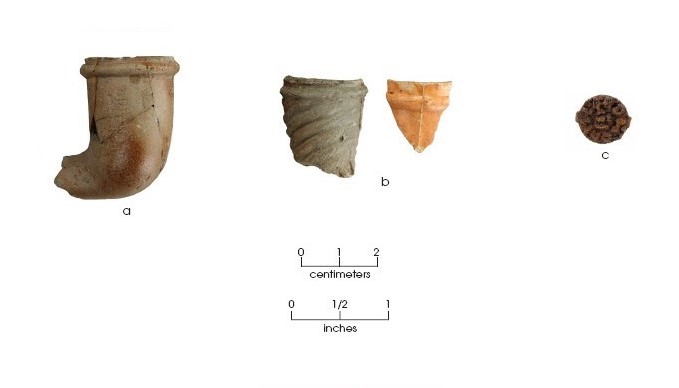
Ingesting various forms of tobacco is an activity that has its roots in the Native American cultures, and it was adopted and spread around the world by Europeans. Tobacco consumption is still popular today, despite the well-documented health risks. At least three forms of tobacco use are represented in the Williams farmstead artifact assemblage: smoking tobacco as evidenced by fragment of three clay pipes (a, b), chewing tobacco as evidenced by a tin tobacco plug tag (c), and snuff as evidenced by numerous snuff bottles. Pipe smoking was a popular activity for many centuries, but it declined in popularity in the late nineteenth century in favor of smoking cigars and cigarettes. We have no evidence for the use of cigars or cigarettes at the farmstead, but such evidence is not likely to survive in the archeological record.
Chewing tobacco came in hard rectangular plugs, wrapped in a paper, and a small iron tag with prongs was pressed into the tobacco to hold the paper wrapper in place. The rusted tobacco plug tag (c) has faint painted letters with the name "LORILLARD." Founded in 1760, the Lorillard Tobacco Company is the oldest, continually operating American tobacco company, and it is the oldest publicly traded company on the New York Stock Exchange. The most common form of tobacco used at the Williams farmstead was powdered snuff and it came in square brown glass bottles.
The farmstead assemblage has a minimum of 23 brown glass snuff bottles(illustrated with other glass bottles; see Kitchen and Household Artifacts), indicating that someone in the Williams household was fond of smokeless tobacco or snuff. One bottle fragment has the letters "PL Co" on it, which was the mark used by Peter Lorillard & Company (a predecessor of Lorillard, Inc.) from 1870 to 1910.
One thing to keep in mind is that tobacco use was popular for both men and women during the late nineteenth century. Ransom might have loaded his pipe full of fresh tobacco, while Sarah might have preferred a pinch of snuff.